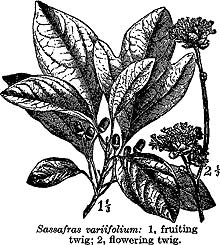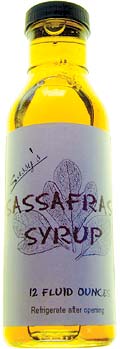Catherine Redcloud was a sickly and stunted child, given to congestions, coughs and wheezes. She needed medicine, but medicine tasted bad. Her grandmother, a Creek Indian from the Poarch Creek Reservation in southern Alabama, knew the solution: Add a little something sweet to the elixirs to mask their bitterness.

In time Redcloud got better—and bigger—but she never lost her taste for sassafras.
“My grandmother died when I was still in my teens,” she says. “And it took about 25 years before I realized that I was really homesick for something. I couldn’t put my finger on it. But it dawned on me that I really missed that syrup.”
Five years ago, she revived her grandmother’s recipe. Last month, she and her husband Joseph went into business selling it.
The process began when the two started a native-plants group in Cherokee, and it was during one of the meetings that the idea took form. “We were having one of our sessions on sassafras and at the last minute I decided make some of that syrup and bring it to the meeting. People just loved it.”
Denise Anthony, project manager for the Stecoah Valley Food Ventures, a commercial kitchen located in Robbinsville, asked Redcloud if she’d thought about selling the syrup. Redcloud had one word for her: “Naw.”
A tree of modest height, sassafras is a member of the laurel family, and distant kin to the noble laurel of Caesar fame, the bay laurel of stew fame and the avocado of guacamole fame. In North Carolina, fellow family-members include red bay, a coastal and sand-hills species; and spicebush, which sprouts along mountain creeks and wetlands elsewhere.

Few North American plants have a longer history than sassafras. Since first coming upon it, the Native Americans have treasured its aromatic roots for their medicinal qualities. In his New Voyage to Carolina, Colonial travel-writer John Lawson wrote at length of its use as medicine. Lawson observed that the Tuscarora Indians he traveled among used fire to remove the outside coating of the roots and then beat them “to a Consistence fit to spread, so lay it on the griev’d Part; which both cleanses a fowl Ulcer; and after Scarrification, being apply’d to a Contusion, or Swelling, draws forth the Pain, and reduces the Part to its pristine State of Health, as I have often seen effected.”
English and Spanish settlers reckoned it a panacea, and trusted it to heal their Old World agues and rheums. (To be clear about things, pretty much every new plant they encountered was accorded some healing power.) Sassafras remained a part of the material medica and a widespread food ingredient until well into the 20th century. You may never have suffered from a “fowl ulcer,” but you’ve likely tasted sassafras, or at least a synthetic version of it: The red-tinged root, along with oil of wintergreen and vanilla, gives root beer its name and characteristic spiciness.
But like the Edsel, Elvis and saddle shoes, sassafras fell on hard times in the 1960s. After lengthy testing, the U.S. Food and Drug Administration declared safrole, a major chemical ingredient in sassafras extract, to be a weak carcinogen, citing its effect on laboratory rats. It’s hard to argue taste against cancer, so food companies severed their relationship to sassafras post-haste, although a few suppliers continue to make safrole-free sassafras concentrate.
That’s the product the Redclouds use to make their syrup, which has been tested and approved by the North Carolina State University food-science department.
Catherine Redcloud says the syrup is perfect for drizzling over pancakes, hot biscuits or ice cream; her own favorite is to serve it over French toast. “You can use it the same way you’d use brown sugar or honey,” she says, adding that it “makes wonderful frosting.”
The syrup is available in 12 oz. bottles for $7.95 each or by the case for $71. The Redclouds also sell gift boxes, which pair sassafras syrup with a 16-ounce bag of “Grandma’s pancake mix” and cost $19.95 each.
And while they’ve only been marketing their syrup for two months, the Redclouds hope that in time it will be a must-have at bed and breakfasts locally and throughout the region.
Sassafras syrup may never banish maple syrup from the table, but if history is any indicator, it has qualities that the latter will never be able to boast of.
“You’re getting a kind of double whammy when you put sassafras on your food,” says Redcloud. “You’re getting good taste and a medicinal kick, too.”
To order Sassy’s sassafras syrup, call (828) 497-4856 or email sassysyrup@hotmail.com. Orders are shipped 3-5 working days after receipt.



could you send a recipe for sassafras syrup please.i have a whole bunch of sassafras roots dug up,and i cant find a recipe nowhere for the syrup.thank you very much for your time.
could you please supply the receipe for sassafras syrup on your web site.